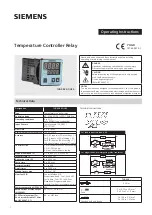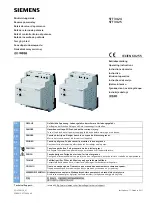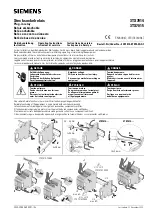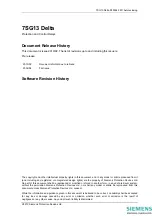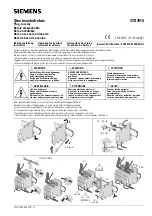
ABB Power T&D Company Inc.
Power Automation and Protection Division
Coral Springs, FL 33065
Instruction Leaflet
All possible contingencies which may arise during installation, operation or maintenance, and all details and
variations of this equipment do not purport to be covered by these instructions. If further information is
desired by purchaser regarding this particular installation, operation or maintenance of this equipment, the
local ABB Power T&D Company Inc. representative should be contacted.
Printed in U.S.A
.
I.L. 41-201S
Supersedes I.L. 41-201R, Dated April 1995
Type CV
Voltage Relay
Effective:
January 1997
( | )
Denotes Change Since Previous Issu
e
!
CAUTION
Before putting relays into service, remove all
blocking which may have been inserted for the
purpose of securing the parts during ship-
ment, make sure that all moving parts operate
freely, inspect the contacts to see that they
are clean and close properly, and operate the
relay to check the settings and electrical con-
nections.
1.
APPLICATION
The Type CV Relays are single-phase induction disc
type relays operating either on under or overvoltage
or both. These relays are applied as a voltage fault
detector operating in conjunction with other protec-
tive relays. The relays are also used as timing
devices for various automatic operations.
2.
CONSTRUCTION AND OPERATION
The types CV-1, CV-2 CV-4, CV-5, CV-6, and CV-7
relays consist of a voltage unit and an indicating con-
tactor switch (ICS). The principal component parts of
the relay and their location are shown in Figures 1, 2,
and 3.
The Type CV-8 relay in addition to the above compo-
nents also has a capacitor which is series tuned with
the main coil of the electromagnet. This tuned circuit
offers a low impedance to fundamental current and a
high impedance to third harmonic currents. Hence,
the relay has a low pickup value for fundamental volt-
age and a much higher value of pickup for third har-
monic voltage. At rated voltage the electromagnet is
saturated causing the circuit to be detuned. The
impedance of the circuit is increased and limits the
fundamental current to a safe value.
2.1.
Voltage Unit (CV)
The overvoltage unit operates on the induction disc
principle. A main tapped coil located on the center
leg of an “E” type laminated structure produces a flux
which divides and returns through the outer legs. A
shading coil causes the flux through the left leg (front
view) to lag the main pole flux. The out-of-phase
fluxes thus produced in the air gap causes a contact
closing torque.
The undervoltage unit operates on the same princi-
ple as the overvoltage unit except the shading coil is
on the right leg (front view). This causes the out-of-
phase fluxes to produce a contact opening torque.
This instruction leaflet applies to the following
types of relay:
CV-1 Long Time Undervoltage Relay
CV-2 Short Time Undervoltage Relay
CV-4 Long Time Overvoltage Relay
CV-5 Short Time Overvoltage Relay
CV-6 Long Time Over or Undervoltage Relay
CV-7 Short Time Over or Undervoltage Relay
CV-8 Low Voltage Pickup Overvoltage Relay
Summary of Contents for CV-1
Page 2: ......


























